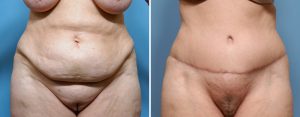Reshaping of one’s stomach and waistline through a tummy tuck or abdominoplasty is a plastic surgery procedure that has a long history of success. The procedure has evolved over the years from the relatively simple excision of loose skin and fat to a more comprehensive procedure that may include liposuction, fascial muscle reshaping and flap tension releasing sutures. While abdominoplasties historically were done as an overnight stay, they are usually done today as an outpatient procedure.

While this is a common postoperative course for tummy tucks today, many people are surprised to hear that it is an outpatient. Their surprise may be one of historical precedent or because they may be concerned about the medical safety of that management approach. There are always ‘reports’ and actual stories of patients who have suffered major medical problems after tummy tuck surgery. While that has not been my experience, the concern is understandable.
So what is the medical evidence of outpatient tummy tuck safety? In a recent 2012 issue of the Aesthetic Surgery Journal, a study from the Division of Plastic Surgery at the University of Texas in Galveston studied this very question. A retrospective study was done on over 300 patients who had a full abdominoplasty with one surgeon over an 18 year period who were done as an outpatient. Postoperative recovery and complications rates were specifically evaluated. The study results showed that no patient developed any major medical problems such as deep vein thrombosis, pulmonary embolism, need for blood transfusion, any intra-abdominal problems or even death. Local complications did occur of which the most common was a fluid collection or seroma formation at a rate of near 20%.
This study supports what many plastic surgeons already know by their own practice experience. Full tummy tucks can be very safely performed and discharged to home within hours after surgery without risk of major medical problems. This does not mean that major medical problems can not occur which is why many precautions are taken before and during surgery. The use of aggressive antinausea prophylaxis, adequate IV fluid hydration, use of sequential lower leg compression devices and good pain control so early ambulation can be done are all important steps that contribute to major complication prevention, particularly deep vein thrombosis and pulmonary embolism.
The success of outpatient tummy tuck surgery is highly dependent on good patient selection. Assessing the patient who is at higher risk of thromboembolism and combining other major plastic surgery procedures with tummy tucks may change the procedure from outpatient to an overnight stay.
Dr. Barry Eppley
Indianapolis, Indiana


